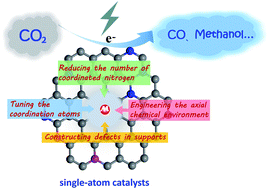Carbon-based single-atom catalysts for CO2 electroreduction: progress and optimization strategies
Abstract
The electrochemical CO2 reduction reaction (CO2 RR) is a promising route to convert CO2 into industrial chemicals and fuels. The viability of CO2 electroreduction depends critically on developing highly active and selective electrocatalysts. As a new frontier in the field of catalysis, carbon-based single-atom catalysts (SACs) with atomically dispersed metal catalytic sites have shown great potential for CO2 electroreduction, and offer opportunities for an in-depth understanding and clear identification of the active sites at the atomic level. In addition, the tunable local environment of metal atoms and supports in SACs made it possible to optimize their electrocatalytic performances for CO2 reduction. However, controllable synthesis and optimization of carbon-based SACs for high-efficiency CO2 RR remain rather challenging. Herein, we summarize the recent advances in the synthesis of carbon-based SACs for CO2 RR, and discuss the mechanisms as well as the influencing factors during the catalytic process. Moreover, some optimization strategies for carbon-based SACs towards CO2 electroreduction are highlighted. At the end of this review article, we present an outlook on the challenges and prospects in this specific research area.



 Please wait while we load your content...
Please wait while we load your content...